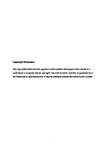Assessment of novel algal biomass sources as potential ingredients in diets for tilapia (Oreochromis niloticus)
| dc.contributor.supervisor | Merrifield, Daniel | |
| dc.contributor.author | Eynon, Ben | |
| dc.contributor.other | School of Biological and Marine Sciences | en_US |
| dc.date.accessioned | 2016-08-12T09:40:26Z | |
| dc.date.available | 2016-08-12T09:40:26Z | |
| dc.date.issued | 2016 | |
| dc.date.issued | 2016 | |
| dc.identifier | 10384110 | en_US |
| dc.identifier.uri | http://hdl.handle.net/10026.1/5282 | |
| dc.description.abstract |
The aquaculture sector is currently seeking alternative feed ingredients to ensure future socioeconomic and environmental sustainability; microalgae sources are seen to be a promising option. Two nutrition trials were conducted in order to assess substituting plant based protein sources in diets for juvenile Nile tilapia (Oreochromis niloticus), with a range of inclusion levels of two proprietary defatted microalgae samples (Nannochloropsis sp. and Chlorella sp.). The experimental algal ingredients utilised were by-products sourced from a pilot-scale biofuel operation. In both trials all experimental algal diets, along with their respective algal free controls, were isonitrogenous and isoenergetic. Fish growth performance, feed utilisation, biological indices, body composition, haematological parameters, histological appraisal of liver and the gastro-intestinal tract and assessment of epithelial skin colouration were evaluated. In trial 1, the final weight gain, specific growth rate, feed conversion ratio, biological indices and survival rate of fish were not affected by Nannochloropsis sp. supplementation (p>0.05). Carcass composition analysis indicated that fish Nannochloropsis (5%, 10% and 15%) had significantly lower body protein and lipid levels. Significantly elevated white blood cell counts, intestinal mucosal fold length and increased hepatocyte nuclei density were observed in fish fed the 15% inclusion. Using a novel photographic application method, 10% and 15% inclusion levels were observed to significantly modulate red spectrum pigmentation. In trial 2, all growth performance, feed utilisation and biological indices investigated showed significant differences at 60% inclusion of Chlorella sp. (p<0.05) with no significant differences in survival compared to control diets. Carcass composition revealed 60% inclusion significantly lowered fish body protein and lipid content, with ash increasing. Significantly elevated granulocyte counts were discovered at 30% and 60% Chlorella sp. inclusion. All algal supplemented diets (15%, 30% and 60%) indicated a significant increase in mid-intestine surface area. Significant increase of hepatocyte nuclei density was also observed in fish fed the 60% inclusion. No amplification of skin colouration was observed in this second trial. These studies indicate great potential for below 15% level inclusions of dried microalgae meal as a by-product from the biotechnology sector; particularly with regards to immunomodulation and promoting external pigmentation, applicable to commercial foodfish and ornamentals alike. | en_US |
| dc.language.iso | en | en_US |
| dc.publisher | Plymouth University | en_US |
| dc.subject | Tilapia | |
| dc.subject | Oreochromis niloticus | |
| dc.subject | By-product | |
| dc.subject | Fish Nutrition, | |
| dc.subject | Microalgae | en_US |
| dc.title | Assessment of novel algal biomass sources as potential ingredients in diets for tilapia (Oreochromis niloticus) | en_US |
| dc.type | Masters | en_US |
| plymouth.version | Full version | en_US |
Files in this item
This item appears in the following Collection(s)
-
01 Research Theses Main Collection
Research Theses Main


